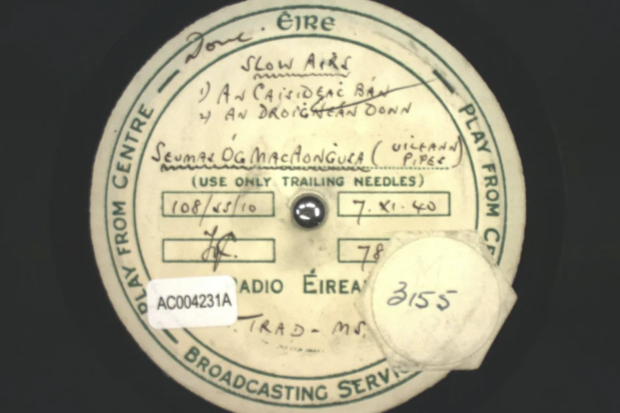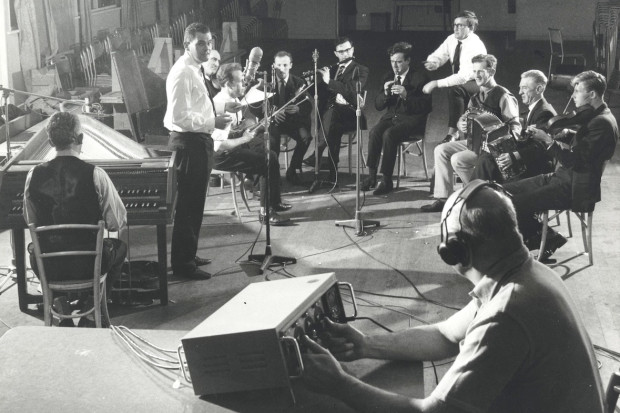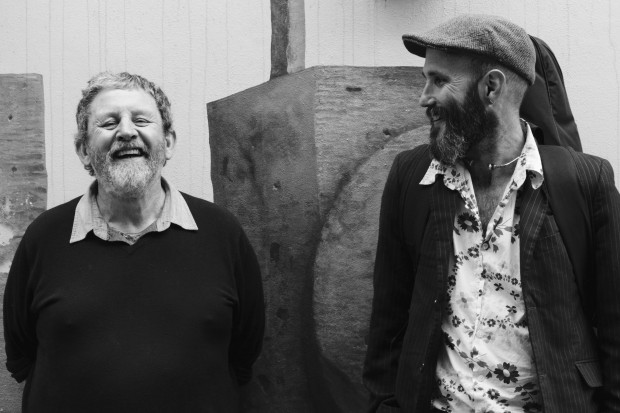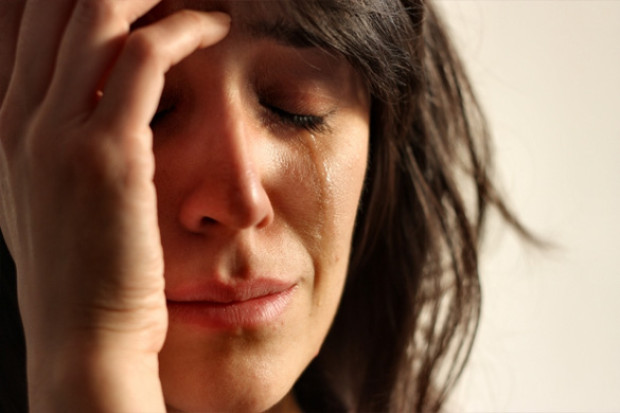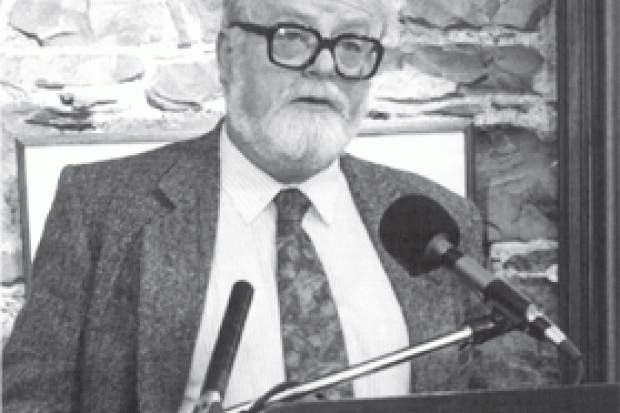Knocking on the Castle Door: A Place for Traditional Music at Third Level?
Traditional musicians believe there is a great ‘worth’ attached to their music, one which for them is constantly being challenged by the ‘imperial’ hegemony of ‘art’ music. Irish indigenous music remained a largely rural, social culture on the periphery of music performance and education in Ireland until the 1960s. Since then it has developed to a high level of virtuosity and professionalism and has now moved into third-level education. This could be interpreted as the ‘breaking out’ of an actively suppressed, indigenous ‘classical’ strand which went underground in the 17th century with the collapse of Gaelic society, re-emerging again in a favourable political and economic clime. It can also be seen as a manifestation of identity affirmation prompted by Ireland’s gradual immersion in the European community. Applying modern musicological thinking to this, it seems perfectly logical that a traditional music appropriate [1] to its base culture should be admitted as a valid, independent area of study at all levels in the education system.
The authority of Ireland’s inherited classical music ‘establishment’ has origins in an English charter of supremacy which on paper dates to at least 1604, if not 1469. This contributes hugely to an exclusivist,[2] stylistic codification in ‘classical’ music and legitimates its control of aesthetic in music education. No criticism of the impressive and intensive, intrinsic music worth of ‘classical’, romantic, ‘art’ and orchestral musics is implied here, but the Victorian textbook attitude is challenged - that which suggests that the history of music starts with innocent ‘folk’ forms, and evolves to the magnificent perfection of the symphony. Instead, the ethnomusicological view is taken - that music is a series of parallel, sometimes inter-related, sometimes independent, culture-specific constructs wherein excellence is judged within local parameters. The view has been around clearly for a half century or more, but only recently is it entering music education.
What we call ‘traditional’ music in Ireland is of course essentially a popular form of ‘local’ and ‘self’ entertainment from before the age of recording. It is dependent on oral and aural transmission of stylistic distinctiveness, and has been shaped and changed over several centuries by largely-rural populations in the process of their casual, ritual and seasonal recreations. Critically, among these people have been aesthetes of the music - performers and listeners, most of them unknown outside their communities, but including also such names as Elizabeth Crotty, Séamus Ennis, Sorcha Ní Ghuairim, Joe Heaney, Willie Clancy, Junior Crehan, John Comac, John Loughran, Paddy Bán Ó Broin, Kitty Linnane, Garech De Bruin, Breandán Breathnach, Con Cassidy and Julia Clifford. That fact is assumed here as the single most important reason for considering the material, effectively, as a genre. This is particularly so with traditional music’s adoption of a corpus of physical artifacts - its accession of transmission media beyond mere flesh and blood.
For over the last fifty years traditional music in Ireland has garnered for itself a distinctive set of vocal, physical and instrumental dimensions, social and artistic expressiveness,[3] standards,[4] orally transmitted stylistics, and graphically, mechanically and electronically presented repertoire. It has large professional and amateur practices, and a definitive media presence with review fora. It is inspired and catered for by ideological, teaching and competitive structures, it has ad-hoc, dedicated and general organisational bodies which enjoy state and local arts funding, and has such recognition as itself at all state levels that there have even been scandals.[5] The music also has both aural and formal standards of assessment, a professional and quasi professional academia, including collectors. It is included in second- and third-level education, with ongoing post graduate research and teaching overseen by specialised persons and institutions. There is too a substantial analytical and documentary literature, and a State-funded archive of all its material productions and representations over some three centuries. The listing of all of this may seem obvious, but as an inventory it implies consequences which involve social acceptance within the Irish state, of a kind which decides how the music is publicly presented, how it is publicly funded - and its place in state education policy.
Yet the music which enjoys supreme stature today in Ireland’s - and indeed in the rest of the Western world’s - education structures is what is loosely known as ‘classical’, increasingly being defined - exclusivistly, and somewhat pompously - as ‘art’ music, set apart from ‘popular’ musics. In its origins ‘classical’ implies characteristics of ancient Greek and Roman art defined by reason, objectivity, restraint, beauty of and strict adherence to form, good taste, clarity, and evocation of 18th century Europe. Yet the term as popularly used today means very little - alluding as it does to a past grandeur, but effectively indicating, ‘music which through the course of time has established itself by reason of its lasting or permanent value’, or again, ‘music of the “golden age”, beginning with Haydn, continuing through Mozart, and concluding with Beethoven’.[6] All quite distinct too from what is termed ‘romantic’ music which is seen as more picturesque, free, imaginative, and a revolt against the classical (Weber, Schumann, Mendelssohn and such). Yet still, to the unspecialised public ear, everything that involves an orchestra is considered ‘classical’, hence, presumably, the introduction of the term ‘art’, and the consequent confused usage of both terms.
The term ‘classical’ too - whether in its populist usage or its strict musicological sense - does properly and necessarily indicate a high degree of dedication, aesthetic discretion, sophistication, exploration of ideas and utilisation of virtuosity. But while all of these attributes are qualities also associated with other genres in the present day - especially ‘folk’ and ‘traditional’ - the term ‘classical’, uniquely, does also imply (bourgeois) ‘society’ music, and is often appreciated too as being ‘nationally’ representative,[7] while still involving a spread from the dabbler, through the dedicated amateur to the wealthy professionalism. Most importantly however, ‘classical’ music seems universally considered by educational establishments world wide to be ‘pure’ music.
This concept of such ‘purity’ in classical music - with composition, orchestration, conducting and prescriptive rigour as key components - has historically controlled the Western sense of aesthetic in music education. All other forms have been considered either as germinal to something ultimately better than themselves, or derivative of something superior. In particular ‘folk’ musics - the popular survival of older forms - have been believed to be backward, an attitude in place in the Irish educational establishment on account of its once being part of a British system. This idea of ‘folk’ as anti-progressive was being imaged iconically at the turn of the 19th-20th centuries in the adoption by trend-setters of the term ‘square’ as a criticism of older country dance formations as opposed to the forward-looking linearity of then modern waltzes.
Even if all that was once perfectly sensible in human development terms, it was already becoming more unsustainable as even the 19th century progressed. And since European ‘art’ music’s elite pedestal in Ireland is linked to residual British ethos in Irish education, what has happened in England itself becomes illuminating. One example is noteworthy, that of the Worshipful Company of Musicians Guild which in 1904 celebrated the 300th anniversary of its charter from James I with a major series of performance-illustrated lectures. The text of these suggests that the WCM’s view of music was as a pyramidal progression of perfection from the bad music and folk dance on the bottom, to the finesse of the ‘classical’ on the top. Cecil Sharpe’s [8] interventional consciousness was invisible to the Guild at the time, even though his Folk Song Society had been around for six years [9] already, and the ‘folk’ music perspectives of such as Bishop Percy had been familiar for more than a century. Reinforcing the pyramidal notion are the Guild’s published celebratory papers [10] which impute the Darwinian idea of folk music as part of natural evolution. Kernel of the elite view is a discourse on Music in England in 1604 [11] which describes the Guild’s charter as being re-granted by:
… that excellent monarch King James I, who knew what he was about … musicians have always been loyal subjects, they have always supported the Crown and served the Constitution
Perhaps in his artistic detachment the writer was unaware that England has no constitution. But it is unlikely that he did not know of its own political song, or the contrary political power of the large body of patriotic song then thriving as popular song in Ireland, not to mention the nationalistic Irish sentiment of Thomas Moore, he who for a couple of decades had been popular-music darling in London drawing-rooms. So one assumes that the ‘loyal subjects’ referred to weren’t either English working class or Irish. That it was ‘classical’ music that the chartered musicians were playing is deduced from the spiel which goes on to defend a privileged role being accorded the blessed musicians, in relation to their ‘being deprived of their legitimate earnings by ignorant rustics and craftsmen … who received large sums of money in various parts of the country through going about from place to place and mumming on festival days’.
The charter’s practical effect was in fact to grant the WCM policing and censorship rights,
jurisdiction over all other minstrels and musicians of the city of London and three miles beyond the city boundaries.
No more than would be expected of any quality control agency. If it were not for the fact that music seems to have always gone beyond the limits of mere standards alone that one would expect to find in - say - building construction, because it is a matter of taste also. But these quotes do still indicate the investment of superior status in favoured people, defined by wealth and royal patronage. In affirmation of this, the 1904 writer can scorn his own contemporary popular music as:
peripatetic organ-grinders and German bands, who are today the plague of London students and sick people.
The kind of music being praised at the time, and considered from as far back as the 1570s as ‘a necessary part of every gentleman’s education’ was of course the ever-evolving ‘classical’ form. Other versions of pretentiousness contributed to the construction of self-righteousness for chaste, upper class presentation of music. Among these is that reported of one John Cooper, music master to James I’s children, who went to Italy to study music - and came back as ‘Signor Giovanni Coperario’.
These attitudes might be fine in relation to the uninterrupted development of music in one land mass, particularly in another age, a period safely before the major re-evaluations of folk musics that the 20th century has championed. But the dogmatism still persists, and as superiority it is hard to view too fondly, for it did in its own time also deliberately ignore the parallel existence in England of a thriving folk music, song and dance, much of which was being collected anyway by figures of intellectual rigour in the later 19th century. That that very folk music was also being ‘lived in’ too during earlier periods when the official record accords it comparative invisibility is borne out by the fact that in the midst of the Puritan period in England, 1654-1661, when minstrelsy was supposed to be repressed, with psalms prescribed instead of dancing, Milton, a Puritan himself, was able to write:
When the merry bells ring round/And the jocund ré-becks [12] sound/To many a youth and many a maid/Dancing in the checkered shade. [Italics mine]
And this period also oversaw the introduction of outlawed church organs to taverns, thereby creating the germ of the music-hall. Later on, William of Orange and the House of Hanover’s view of dance as ‘sinful’ appears to have had little effect either.
The existence of such prohibition - and its being rendered ineffective among the plain people then too - is reflected in the mid-20th century American, and later-1960s Chilean, views of folk musics as agents of sedition. Edinburgh University’s Hamish Henderson asserted this in the borrowed words of playwright Joe Orton as ‘there is nothing so dangerous as the voice from below’ - culturally, socially, intellectually and artistically as well as in class. Indeed in earlier times in Ireland, the music-loving Elizabeth had harpers banned; pipers inherited the favour. All of it reinforces the notion of the ‘classical’ as a ‘kept’ art, an ally of the upper classes - in James I’s words 400 years ago: ‘musicians … always … loyal subjects’. With such a history being taken as Gospel truth as late as the year 1904, the actual appearance - and ascent to the primary school syllabus - of the often-maligned folk-song collector and advocate Cecil Sharp was therefore quite revolutionary.
These are a stray collection of quotes, plucked from a volume picked up by chance in a New York used-book store. But they fill in an ideological background, highlighting the gradual compounding of rigorous dominance for the classical which today still affects the artistic apprehension of indigenous folk musics, particularly among young people. And because of a music education system inherited from Britain, the same has applied in Ireland too. The revival of traditional musics in Ireland, England, Scotland and Wales has, however, challenged it, this in Ireland having been a remarkably efficacious process in the years since 1951 for gaining a solid foothold and eventual public funding ‘appropriate to its cost-base and scale of practice’.[13]
Traditional music drew its ideology from ‘small-nations’ thinking which gave validity to rebellion against empires, and which, paradoxically, was also a product of the same era in which the Worshipful Company celebrated its charter of judgmental superiority. But its notions of ‘quality’ and ‘correctness’ are subjective concepts, consequent to political favour, beliefs and cultural era constraints. Perceived ‘stepping stone’ or ‘derivative’ forms - so-called ‘folk’ musics, and in turn their consequences in jazz and rock - have been shown by the ascent of the ‘ethno’ in musicology, and the wizardly compliance of electronics, to have their own immense, historically validated systems of aesthetic, rigour and appreciation. They have in fact produced such a volume of material and practice to warrant themselves ‘classicised’, and be regarded as a ‘genre’. This weakens ‘classical’ as a term exclusive to its usual pedagogic associations, and suggests that it should be viewed as one of a range of options for music education. Certain educators in Ireland [14] and elsewhere argue convincingly that there is nothing required in the rigour of music pedagogy which can not be provided by any of several, so-defined genres of music. And there is an equal case to be made for the validity of the oral within these as a method of imparting style at all levels of a re-focused music education.
This paper was given to the British Forum for Ethnomusicology conference, Edinburgh, April 11-13, 2002
Notes
1. Including, for instance, Scottish highland and lowland forms, Northern England, Wales, Essex, Yorkshire, etc., as opposed to the study of traditional musics from unrelated places abroad.
2. One which, for instance, excludes as invalid such qualities as, for instance, timbre and context in ‘folk’ forms.
3. The learning/teaching, session, organisational, fleadh cheoil and summer school environments occupy a sizeable portion of community and artistically-expressive space, one which did not exist in any comparable form before revival proper began in 1951.
4. After the inception of the fleadh cheoil, these were for long set by adjudicator preferences, but since the proliferation of album production that escalated in the later 1970s they now seem largely inspired by professional players, and indeed recording-studio aesthetics.
5. For instance, the 1999 Report on Traditional Irish Music prepared by Senator Labhrás Ó Murchú for the Government of Ireland – Houses of the Oireachtas Joint Committee on Heritage and the Irish Language produced considerable controversy.
6. Arbitrarily chosen descriptions, taken from the 1954 popular-market, 2,239-page A-Z compendium The World of Music.
7. Traditional music is now included in political/cultural representations of Ireland abroad, a process that dates to the World’s Fair in Chicago, 1899, at least, including forays abroad by such as Séamus Ennis to Italy, and piper Sean Dempsey in Germany who played uilleann pipes at the controversial 1936 Berlin Olympic Games (while seated on the back of a German soldier, the authorities having provided no chair, assuming that pipes were to be played standing up). Breaking this trend (and hugely indicative of the destructiveness of ‘classical’ music hegemony) was the 2001, Music Network initiative ‘Musicwide International’. Financed by the Irish Dept. of Foreign Affairs, this was insultingly launched with 19th century German music, and initially promoted four headline groups, three of them classical and one ‘contemporary’; traditional music was not included, nor was Jazz.
8. Cecil Sharp (1859-1924), a music educator, applied himself to folk music after observing Morris dance at Oxfordshire in 1899. He subsequently collected English and English-related song at home and in areas of British colonial influence in the Appalachian mountains of the USA. He brought his expertise and dedication together with the formation of the society for the encouragement of English folk Dance in 1911
9. The English Folk Song Society was formed in 1898.
10. These were published as English Music, ed. by Frederick, J. Crowest, in seventeen discrete articles by various authorities.
11. Given by Frederick Bridge.
12. Rebec, a plucked instrument from Islamic culture popular in later medieval Europe, and which might still cause terror among conservatives for being symbolic in ‘Eastern’ musics such as that of Afghanistan.
13. This kind of ‘spin’ on support for traditional music was being used by the Arts Council of Ireland by January 2002, and by the Scottish Arts Council in April 2002. Presumably it permits Arts councils to continue to spend huge sums on opera, orchestra and such as ballet while also getting credit for supporting traditional forms.
14. See Burgess, Barry, and Smith, Therese, in Crosbhealach an Cheoil – the Crossroads Conference, papers published by Whinstone, Dublin, 1998
Published on 1 July 2002
Fintan Vallely lectures in traditional music at Dundalk Institute of Technology. He is author of several biographical and ethnographic books on the music, and is editor of the A-Z reference work Companion to Irish Traditional Music.












